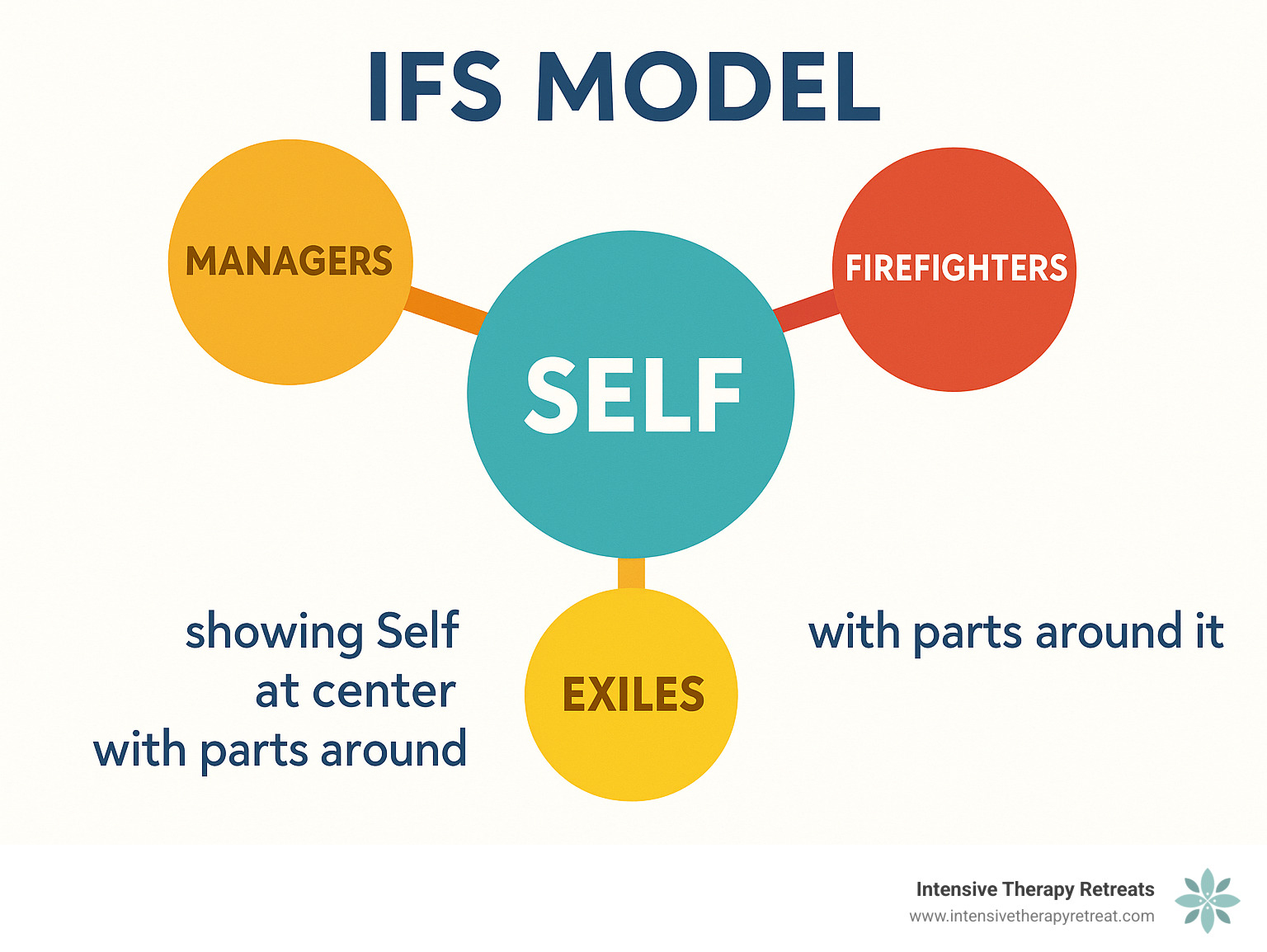What is Your Internal Family?
Internal family systems therapy exercises help you connect with and heal the different parts of your inner world. These techniques allow you to dialogue with protective parts, access your core Self, and create inner harmony.
Quick Reference: Essential IFS Exercises
- Parts Mapping – Visualize your internal system through drawing
- Journaling Dialogue – Write conversations with your parts
- The Six Fs – Find, Focus, and Befriend specific parts
- Body Scan – Locate where parts show up physically
- Chair Work – Give each part its own voice and perspective
- Guided Meditation – Access Self-energy and the 8 Cs
- Room Technique – Observe parts from a safe distance
- 8 Cs Exploration – Cultivate Self-leadership qualities
Have you ever said, “Part of me wants to go, but another part feels scared”? That’s your internal family. Internal Family Systems (IFS), developed by Dr. Richard Schwartz, sees us as having different subpersonalities or “parts.” There are no bad parts.
Your internal system includes protective Managers, reactive Firefighters who jump in during crisis, and vulnerable Exiles who carry past wounds. At your core is the Self—your wise, compassionate center that can lead with curiosity and calm.
When parts conflict or get stuck in extreme roles, you might feel anxious or overwhelmed. When your Self is in leadership, you can access qualities like courage and creativity that promote healing.
I’m Dr. Bambi Rattner. At Intensive Therapy Retreats, I use methods like EMDR and IFS to help people transform by working compassionately with their internal parts.
Meet Your Inner Team: The Self and Your Parts
Internal Family Systems (IFS) therapy helps you understand yourself as a team of different subpersonalities, or “parts.” These aren’t abstract ideas; they show up as thoughts, emotions, and body sensations, like an “inner critic” or an “anxious part” that makes your stomach flutter. This is a normal part of being human.
Within this internal system, IFS groups our parts into three main categories:
-
Managers: These proactive parts work to keep you safe and organized. They strive for perfection, plan carefully, and control situations to prevent pain or shame. For example, a manager might organize your schedule, push for success, or downplay feelings to appear strong. While well-intentioned, their methods can lead to perfectionism, self-criticism, or people-pleasing.
-
Exiles: These are young, vulnerable parts that carry the burdens of past pain, trauma, and difficult emotions. Managers often work to keep Exiles hidden, fearing their pain will be overwhelming. Because they are isolated, Exiles can feel abandoned and need healing.
-
Firefighters: When an Exile’s pain threatens to surface, Firefighters jump in. These reactive parts try to “put out” emotional fires with impulsive or extreme behaviors to distract from the pain. Common Firefighter activities include substance use, binge eating, excessive shopping, or self-harm. Their goal is protective, but their methods can create more problems.
A core tenet of IFS is that all parts, even those with difficult behaviors, have positive intentions. They are trying to help, protect, or manage pain in the best way they know how. There are no bad parts.
At the core of our internal system is the Self, distinct from all parts. The Self is your inherent, undamaged center of wisdom, compassion, and healing. It’s always there, regardless of your experiences. When you are “in Self,” you embody the 8 Cs of Self-energy:
- Curiosity: An open, non-judgmental interest in your inner world and others.
- Calm: A feeling of peace and groundedness, even when things are chaotic.
- Confidence: A deep trust in your own abilities and inner wisdom.
- Compassion: Kindness and understanding towards yourself and your parts.
- Creativity: The ability to find new solutions and fresh perspectives.
- Clarity: A clear understanding of situations and intentions.
- Courage: The bravery to face challenges and difficult emotions.
- Connectedness: A sense of belonging and connection to others and the world.
The Practice of Internal Family Systems (IFS) teaches that the goal of IFS therapy is to help parts release extreme roles and trust the Self’s leadership. When your Self leads, your internal system becomes harmonious, allowing you to engage with the world from a place of strength. The healing relationship between your Self and your injured parts leads to lasting change. Internal family systems therapy exercises help you cultivate this Self-leadership.
8 Practical Internal Family Systems Therapy Exercises to Try
Now that you understand your internal family, it’s time to connect with your parts. These internal family systems therapy exercises are a toolkit for your inner world, helping you build relationships with aspects of yourself, heal, and develop self-awareness for lasting change. Each technique offers a way to understand how your parts show up, what they need, and how they try to help.
1. The Six Fs: Find, Focus, and Befriend Your Parts
The Six Fs is a foundational internal family systems therapy exercise that provides a structured way to approach any part with curiosity.
- Find: Notice a part. It could be a knot of anxiety in your stomach or a critical inner voice. Notice where it lives in your body or the thoughts it shares.
- Focus: Gently turn your attention toward this part without trying to change it. Just acknowledge its presence.
- Flesh out: Get curious about the part’s details. What is its age or personality? Does it have a particular way of speaking?
- Feel toward: Check how you feel toward the part. If you feel irritation or fear, that’s another part. Ask it to step back so you can approach from your Self with curiosity and compassion.
- Befriend: Start a conversation. Ask, “How are you trying to help me?” or “What are you worried would happen if you stopped?” Listen for answers in thoughts, images, or sensations.
- Fears: Dig deeper to understand the part’s core fears. A perfectionist part might fear rejection; an angry part might fear being taken advantage of.
This process helps you build a better relationship with yourself. You can dive deeper with this Six Fs Internal Family Systems worksheet, and find more resources on our Internal Family Systems Therapy Worksheets page.
2. Parts Mapping: Create a Visual Guide to Your Inner World
Parts mapping helps you visualize your inner world on paper, turning abstract feelings into concrete images. This internal family systems therapy exercise clarifies the big picture.
- Drawing: You don’t need to be an artist. Use stick figures or simple shapes to give each part a visual form that makes sense to you. For example, your inner critic could be a stern figure, or your anxious part could be swirling lines.
- Diagramming: Draw lines or arrows to show the relationships between parts. This can reveal patterns, like how a people-pleasing part and a perfectionist part might work together to protect you from criticism.
- Visualizing relationships: This helps you spot polarizations, or internal battles between parts. For example, an adventurous part might conflict with a security-focused part. Seeing this on paper clarifies internal struggles.
Creating this visual map is a powerful tool for daily check-ins. The Identifying Parts of Yourself Through Drawing worksheet offers helpful guidance.
3. Journaling: A Written Dialogue with Your Parts
Journaling is an accessible internal family systems therapy exercise that slows down mental chatter, allowing you to hear your parts. Writing creates a safe space for authentic inner dialogue and self-therapy.
Start by noticing a part and writing down its experience, like, “I feel a tight knot in my chest and racing thoughts about tomorrow.” Then, from your Self, ask gentle questions using writing prompts like, “What do you need me to know?” or “How are you trying to help?” Trust the responses that arise.
A part might answer, “I’m trying to prevent you from being humiliated like you were in college.” You can then respond from Self with appreciation: “Thank you for trying to protect me.”
This written dialogue helps you understand the motivations behind your parts’ behaviors. To learn more, explore How Does Internal Family Systems Therapy Work?.
4. The Room Technique: A Safe Space for Observation
When a part feels too overwhelming, the Room Technique offers a gentler approach. This internal family systems therapy exercise uses visualization to create emotional distance, helping you observe parts without getting swept away by their intensity.
First, imagine a comfortable, safe room in your mind—your internal sanctuary. Then, invite a challenging part into this room, but keep it at a distance, perhaps behind a one-way mirror. This allows for safe observation.
The goal is unblending from parts. Instead of being consumed by anxiety, you can observe your anxious part from your Self and notice, “That part is really activated. It seems so worried about keeping me safe.”
From this distance, you can ask questions and gain insights without direct dialogue. This technique is valuable for parts carrying trauma. Learn more in The Power of Internal Family Systems (IFS) to Steer Trauma.
5. Guided Meditation: Connecting with Self-Energy
Meditation is an internal family systems therapy exercise that helps you connect with your core Self and cultivate the calm, curious energy needed for healing. Self-energy feels spacious and warm, and accessing the 8 Cs happens naturally when parts step back to let your Self emerge.
Find a quiet space and settle in. Use mindfulness to stay present with whatever arises without judgment. From your Self-energy, you might gently invite, “Is there a part that would like to make itself known?”
Pay attention to any sensations, images, or thoughts that arise. These are your parts responding. From your Self, you can offer appreciation: “Thank you for showing yourself to me. I’m here and I’m listening.” This simple acknowledgment can be profoundly healing for parts that have felt ignored.
You can find helpful resources like our Guided IFS meditation resource to support your practice.
6. Body Scan: Locating Where Your Parts Live
A body scan is an internal family systems therapy exercise that strengthens your mind-body connection. It helps you recognize how parts show up as physical sensations.
Somatic awareness means listening to your body’s language. A tight throat might be a part that’s afraid to speak; a heavy chest could be grief; a tense jaw might be anger.
To practice, lie down or sit comfortably. Slowly scan your attention from your toes to your head, noticing any sensations without judgment. When you notice a sensation, like a knot in your stomach, get curious: “Is there a part of me here? What is it trying to tell me?”
This practice helps you develop a more intimate relationship with your body as a source of wisdom. Regular body scans can help you notice parts before they become overwhelming. This is valuable for addressing Various Mental Health Conditions That IFS Can Help With.
7. Exploring the 8 Cs: A Practical IFS Therapy Exercise for Self-Leadership
Self-leadership means operating from your core Self instead of being driven by reactive parts. This internal family systems therapy exercise helps you recognize and strengthen the qualities of Self.
The 8 Cs are already within you; they emerge when parts feel safe to step back. Reflection on these qualities helps you notice when you’re in Self. Cultivating Self involves gentle practice and awareness. Reflect on moments when you felt genuinely curious instead of judgmental, or when you remained calm in a crisis.
Consider each of the 8 Cs: When do you feel most confident? How does compassion feel in your body? What helps you access your creativity? You might notice that courage isn’t fearlessness, but the willingness to stay with difficult feelings.
This isn’t about perfection. It’s about recognizing these qualities and understanding what helps them flourish. The What the Self Is and Isn’t in IFS Therapy worksheet can guide this exploration.
8. Chair Work: Giving Each Part a Voice
Chair work is a dynamic internal family systems therapy exercise that makes abstract parts tangible. It helps you externalize parts and gain perspective on their roles.
This role-playing exercise uses chairs to represent your Self and different parts. Start in your Self chair, connecting with your 8 Cs. Then, move to a part’s chair to embody its perspective. For example, in the inner critic’s chair, you might say, “You should have done better on that project.”
Move back to the Self chair to respond with curiosity and compassion: “I see you’re working hard to help me improve. What are you worried would happen if you weren’t so vigilant?”
This externalizing process helps you relate to parts with compassion instead of being overwhelmed by them. Chair work is especially helpful for exploring polarizations—internal conflicts between parts. This is one of many powerful Internal Family Systems Interventions that can create breakthroughs.
The Goal of IFS: Fostering Inner Harmony and Healing
Practicing these internal family systems therapy exercises helps you build a peaceful, harmonious relationship with all aspects of yourself. The goal is to foster self-compassion, inner conflict resolution, and healing trauma.
You learn to approach difficult parts with curiosity instead of judgment. When your Self leads, it can mediate internal battles, helping parts communicate and find solutions that honor all needs. This reduces anxiety and conserves energy.
These exercises also offer a path to healing trauma. Your Self can provide care to your vulnerable Exile parts, which hold pain from past experiences. The process of unburdening parts isn’t about forgetting the past, but about freeing yourself from its weight.
Most importantly, these exercises develop Self-leadership. You learn to access your calm, confident Self, even during challenges. When your Self leads, your parts can relax from their extreme, protective roles and offer their natural gifts.
This work can improve every area of life. Anxiety and depression can decrease, relationships improve, and patterns like perfectionism soften. At Intensive Therapy Retreats, we see clients find this internal harmony. The journey addresses the root of struggle—disconnection from our authentic Self—and leads to lasting peace and confidence. This is the Positive Impact of Internal Family Systems Therapy (IFS) that transforms lives.
Frequently Asked Questions about Internal Family Systems Therapy Exercises
It’s natural to have questions as you start this journey of understanding your inner world. Here are some common questions about internal family systems therapy exercises and the IFS model.
What are the three main types of parts in IFS?
The three main types of parts are:
- Managers: Proactive protectors that manage daily life to keep you safe and prevent pain. They can manifest as perfectionism or emotional control.
- Exiles: Young, vulnerable parts that hold pain, shame, and trauma from past experiences. They are often hidden by Managers.
- Firefighters: Reactive protectors that “put out” emotional fires when an Exile’s pain surfaces. They use impulsive behaviors like substance use or binge eating to distract from the pain.
All parts have positive intentions, even if their methods are problematic. In IFS, there are “no bad parts.”
Can I do IFS exercises on my own?
Yes, many internal family systems therapy exercises like journaling and parts mapping are excellent for self-exploration. Practicing on your own can increase self-awareness and help you build relationships with your parts.
However, for deeper healing, especially with trauma or complex internal dynamics, working with a trained IFS therapist is highly recommended. A therapist provides a safe, guided space to approach vulnerable parts and facilitate the unburdening process. While self-practice is valuable, professional guidance is crucial for deep healing involving trauma.
What does it mean to be ‘Self-led’ in IFS?
Being “Self-led” is the goal of IFS. It means you are operating from your core Self—your inherent center of wisdom and compassion. When Self-led, you embody the 8 Cs (Calm, Curiosity, Confidence, etc.) and interact with your parts and the world from a grounded, centered place. Instead of being controlled by reactive parts, your Self is in the lead. This allows your parts to relax from their extreme roles and creates internal harmony, authenticity, and peace.
Begin Your Journey to Inner Wholeness
You’ve learned how internal family systems therapy exercises can help you befriend your inner ‘parts.’ This journey can help you move from feeling at war with yourself to finding a deep sense of inner calm and wholeness.
While you can do many of these exercises on your own, for deeper healing of past hurts, a trained IFS therapist provides the safety and guidance needed for lasting peace.
At Intensive Therapy Retreats, we offer immersive therapy experiences. We combine proven methods like Internal Family Systems (IFS), EMDR, and ART to help you achieve significant, lasting changes in days, not years. Our focused work open ups your natural ability to heal and lead your life from a place of inner strength.
If you’re ready to turn inner conflict into collaboration, we invite you to learn more. Imagine your inner parts working together in harmony. We can help you make that a reality. Find out more about our specialized IFS Therapy Retreats and let us guide you toward a more harmonious and fulfilling life.




